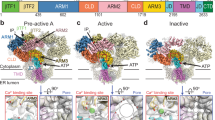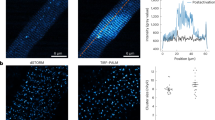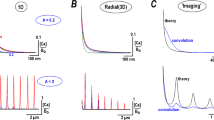Abstract
Recent theoretical analysis of a model lattice of interacting transmembrane receptor proteins has indicated that such clustering in the membrane could provide a novel mechanism for regulating receptor signalling in cells1,2. It has been calculated that cooperative interactions between receptors organized into a cluster, or array, in the membrane would dramatically increase their sensitivity to activation by ligand1,2. Sensitivity to ligand would increase with the extent of spread of activity within the receptor lattice. Hence, formation of extensive receptor lattices in the membrane would allow a large population of receptors to be simultaneously switched on, or off, by a very small change in ligand concentration. We show here that lattice formation is an intrinsic property of an integral membrane protein, the ryanodine-sensitive calcium-release channel (RyR) of endoplasmic reticulum. The purified protein spontaneously assembled into two-dimensional lattices in solution, enabling the construction of a 25 Å projection map that identifies the mode of interaction between RyR oligomers. Our observations on the RyR provide a new perspective on various properties of cell signalling via this and other receptors.
This is a preview of subscription content, access via your institution
Access options
Subscribe to this journal
Receive 12 print issues and online access
$209.00 per year
only $17.42 per issue
Buy this article
- Purchase on Springer Link
- Instant access to full article PDF
Prices may be subject to local taxes which are calculated during checkout


Similar content being viewed by others
References
Bray, D., Levin, M. D. & Morton-Firth, C. J. Nature 393, 85–88 (1998).
Duke, T. A. & Bray, D. Proc. Natl Acad. Sci. USA 96, 10104–10108 (1999).
Lai, F. A., Erickson, H. P., Rousseau, E., Liu, Q. Y. & Meissner, G. Nature 331, 315–319 (1988).
Wagenknecht, T., Grassucci, R., Frank, J., Saito, A., Inui, M. & Fleischer, S. Nature 338, 167–170 (1989).
Radermacher, M. et al. J. Cell Biol. 127, 411–423 (1994).
Serysheva, I. I., Orlova, E. V., Chiu, W., Sherman, M. B., Hamilton, S. L. & van Heel, M. Nature Struct. Biol. 2, 18–24 (1995).
Franzini-Armstrong, C. FASEB J. S266–S270 (1999).
Marx, S. O., Ondrias, K. & Marks, A. R. Science 281, 818–821 (1998).
Cheng, H., Lederer, W. J. & Cannell, M. B. Science 262, 740–744 (1993).
Tsugorka, A., Rios, E. & Blatter, L. A. Science 269, 1723–1726 (1995).
Klein, M. G., Cheng, H., Santana, L. F., Jiang, Y. H., Lederer, W. J. & Schneider, M. F. Nature 379, 455–458 (1996).
Gonzalez, A. et al. Proc. Natl Acad. Sci. USA 97, 4380–4385 (2000).
Cheng, H., Fill, M., Valdivia, H. & Lederer, W. J. Science 267, 2009–2010 (1995).
Bray, D. Annu. Rev. Biophys. Biomol. Struct. 27, 59–75 (1998).
Crowther, R. A., Henderson, R. & Smith, J. M. J. Struct. Biol. 116, 9–16 (1996).
Acknowledgements
We thank N. Unwin, R. Henderson and D. Trentham for helpful discussions and encouragement, and the British Heart Foundation for grant support.
Author information
Authors and Affiliations
Corresponding author
Rights and permissions
About this article
Cite this article
Yin, C., Lai, F. Intrinsic lattice formation by the ryanodine receptor calcium-release channel. Nat Cell Biol 2, 669–671 (2000). https://doi.org/10.1038/35023625
Received:
Revised:
Accepted:
Published:
Issue Date:
DOI: https://doi.org/10.1038/35023625
This article is cited by
-
Live-cell photoactivated localization microscopy correlates nanoscale ryanodine receptor configuration to calcium sparks in cardiomyocytes
Nature Cardiovascular Research (2023)
-
Voltage sensing mechanism in skeletal muscle excitation-contraction coupling: coming of age or midlife crisis?
Skeletal Muscle (2018)
-
Ryanodine receptors are part of the myospryn complex in cardiac muscle
Scientific Reports (2017)
-
Structural insights into Ca2+-activated long-range allosteric channel gating of RyR1
Cell Research (2016)
-
Calcium handling proteins: structure, function, and modulation by exercise
Heart Failure Reviews (2014)



